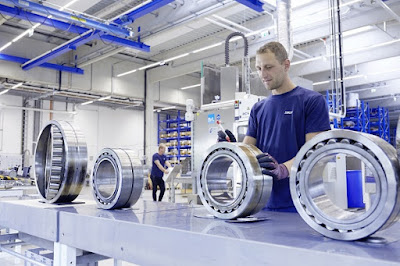Bearing renovation techniques
Welcome to our latest post on bearing renovation techniques! As industrial machinery ages, bearings can deteriorate and fail, causing costly downtime and safety risks to workers. Rather than replacing bearings entirely, bearing renovation has become a practical and cost-effective approach to extending the life of machinery components. Quicker and less expensive than replacing entire bearings, renovation can restore older bearings that would otherwise be discarded.
In this post, we will delve into the latest techniques for bearing renovation, exploring various methods and highlighting the benefits and potential drawbacks of each. Our goal is to provide a comprehensive guide for engineers, operators, and maintenance professionals to help them make informed decisions on when and how to renovate bearings. We will also discuss how bearing renovation can be a viable option for reducing maintenance costs and maximizing the performance of rotating equipment.
Whether you are a manufacturer seeking to improve equipment uptime or a maintenance professional looking for ways to reduce costs, this post is for you.
1. Disassemble the bearing to inspect for wear and tear.
In the field of mechanical engineering, bearing renovation is an essential aspect of ensuring the smooth operation of various machines. One of the critical steps in the bearing renovation process is inspecting the bearings for wear and tear. To do this effectively, the bearings must be disassembled to allow for a detailed inspection. During this inspection, it is necessary to examine various parts of the bearing, including the cage, rollers or balls, outer and inner rings, and seals. Any signs of wear or damage, such as cracks, dents, or deformation, should be noted and repaired promptly to prevent further damage or failure. In conclusion, disassembling the bearings for inspection is a crucial technique in the bearing renovation process, and it must be performed meticulously to ensure optimal performance and durability.
2. Clean the bearing thoroughly to remove any dirt or debris that may cause damage.
Cleaning the bearing thoroughly is a crucial step in the renovation process, as it helps to remove any dirt or debris that may cause damage to the bearing. Before starting the cleaning process, it's important to wear protective gear such as gloves and eye protection to prevent injury. Begin by removing the bearing from its housing and using a brush and solvent to remove any visible contaminants. Next, rinse the bearing with clean water to remove any remaining dirt or debris. Pay particular attention to the balls or rollers and raceways, as these areas are especially susceptible to damage if not cleaned properly. Once the bearing has been cleaned, allow it to air dry completely before proceeding with any further steps in the renovation process.
3. Replace any worn or damaged parts with new ones.
When renovating bearings, it is important to replace any worn or damaged parts with new ones. This step is essential to ensuring the longevity and performance of the bearing. If worn or damaged parts are not replaced, they can cause further damage or failure of the bearing, which can lead to costly repairs and even safety hazards. Replacement parts should be of the same quality and specifications as the original parts to ensure proper fit and function. Careful inspection of the bearing during renovation will identify any parts that need to be replaced, and a thorough record of all replacements should be kept for future reference. By replacing worn or damaged parts with new ones, the bearing can operate at its full capacity, providing optimal performance and reduced downtime.
4. Lubricate the bearing with the appropriate grease or oil to ensure proper functioning.
When it comes to maintaining and renovating bearings, proper lubrication is crucial to ensure optimal functioning. Before applying any grease or oil, it is important to ensure that the bearing is clean and free from any debris or contaminants. Failure to clean the bearing before lubricating it can result in poor performance and even damage to the machine. Once the bearing is clean, it is essential to use the appropriate type of lubrication to ensure proper functioning. Using an incorrect type of grease or oil can lead to a buildup of friction and wear, reducing the lifespan of the bearing. By taking the time to lubricate the bearing correctly, you can ensure that your machinery runs smoothly and efficiently, reducing the need for costly repairs and downtime.
5. Reassemble the bearing and perform a test run to check for any issues.
As a critical component of many industrial applications, bearings bear the brunt of constant wear and tear. Over time, they require renovation to restore their functionality and mitigate the risk of unplanned downtime. In order to properly renovate bearings, it is essential to follow a systematic process that involves several key steps. Once the bearing components have been cleaned and inspected, the next step is to reassemble the bearing. When reassembling the bearing, care should be taken to ensure that all components are aligned and fitted properly. Once reassembled, conduct a test run to check for any issues like abnormal vibrations, noises and excessive heat. Any issues should be identified and promptly addressed before putting the renovated bearing back into operation. By following these bearing renovation techniques, it is possible to ensure that bearings remain reliable and functional for their intended lifespan, helping to minimize the risk of unplanned downtime and maximize operational productivity.
In conclusion, bearing renovation can be an effective way to restore and improve the performance of bearings without needing to replace them altogether. Whether you choose to use chemical cleaning, regrinding, or some other method of renovation, it is important to follow proper techniques for best results. By investing in the maintenance and repair of your bearings, you can ensure that your equipment runs smoothly and efficiently for years to come, ultimately saving you time and money in the long run.




Megjegyzések
Megjegyzés küldése